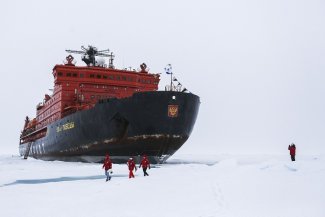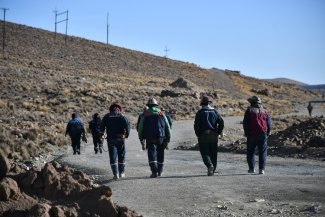Most of Kivalina’s inhabitants struggle to give a clear response to the question: “How long do you think you’ll be able to continue to live in your homes?” Only Millie Hawley, director of the city relocation office, is emphatic in her response: “Two years”. This is the harsh reality facing the residents of this small Alaskan community, not knowing how long their homes will be safe.
The settlement is perched on a barrier reef between the Chukchi Sea and the Kivalina Lagoon, into which the Wullik and Kivalina Rivers flow, turning the atoll into an island. This delicate location makes the inhabited enclave highly sensitive to rising sea levels – the product of global warming and melting Arctic ice.
The loss of terrain has been particularly pronounced over the last decade. The erosion caused by increasingly fierce storms, together with the rising sea level, means that the displacement of its population is inevitable.
The situation is by no means new. The proposal to relocate the entire village dates back to the 1990s, but very little progress has been made in this direction. In 2008, the US government approved funding for the construction of a stone dike along the coast of Kivalina, which has helped to slow the loss of land to the ocean, but has not resolved the problem – far from it.
Unfortunately, according to experts, what is happening in Kivalina will cease to be an isolated event, becoming a widespread reality in many other parts of the globe. For Kivalina there is no turning back: relocating the village is the only solution. These Alaskans are amongst the first to suffer the consequences, but what is happening in the Arctic is affecting the entire planet.

Aerial photo of Kivalina, Northwest Arctic Borough, Alaska, United States. This will be the first place in the US to be left completely under water by climate change.
One of the main obstacles to relocating the village of Kivalina is the cost. There is no talk of concrete figures or budgets, but it is estimated that the relocation will cost about US$400 million.
Beyond the unspecified dates and figures, Hawley explains that what has been decided is that, by 2019, work will start on a road to evacuate the locals. The budget for this alone is US$55 million. Currently, the only way of getting to or from Kivalina is by light aircraft, available all year round, and, between June and October, by boat. In the event of flash floods or heavy swells, the population would be left with no safe escape route.

Jerry Norton Jr crosses the Kivalina Lagoon on his boat. The late and unstable formation of sea ice means that the Iñupiat people have to adapt to new circumstances every season.
According to experts, the annual temperature rise in the Arctic is twice the global average. With every passing year, winter starts later, is shorter and less cold. One of the consequences is that the sea ice protecting Kivalina is shrinking and growing thinner. And this not only increases the water level and the rate of erosion, it also has a direct impact on the traditional way of life of the Iñupiat, the ethnic group to which the Kivalina population belongs.

Light aircraft is the only means of transport in and out of Kivalina (all year round, except when conditions are adverse). Every time a plane lands, residents gather to collect packages of goods to which they have limited access in this remote community.
Hunting and fishing are the main source of sustenance for the almost 400 locals, so their livelihood is tied to the conservation and predictability of the ecosystem that surrounds them. Climate change, however, is affecting the seasons, migratory patterns and habits of the species the Iñupiat usually hunt and fish.
Austin Swan Sr, the mayor of Kivalina, explains: “We have had to adapt to later hunting seasons for most of our subsistence foods, due to changes in migration patterns. Take whale hunting, for example. We haven’t caught a whale since 1994 and that’s because of the unstable ice conditions. The ice sheets are not as thick as they used to be, nor do they overlap like they used to. We have to be very careful about the direction of the wind and under-ice currents, especially when we’re camping on sea ice.”

From left to right, Kyle Sage, Tommy Emma, Byron Tyler and Clinton Swan. The four men drag a net full of trout to their boat. The fishermen travel by boat up the Wullik River for several hours in search of this freshwater fish.
The Iñupiat in Kivalina begin hunting and fishing at such an early age that they are already experts by the time they reach adolescence. Kyle Sage, 27, is one of the youngsters of the village. He started fishing with his grandfather when he was four years old: “I’m seeing a lot of changes. Climate change is here. Fifteen years ago, we would already be on sea ice in November, looking for something to hunt, but nowadays there is no ice at all.” Despite the difficulties and the constant need to adapt, none of the young people in the village are considering leaving their community.

Residents of Kivalina pose for pictures in front of their homes. From left to right and top to bottom: Joe Swan, 82, is Kivalina’s oldest man. Alexis Halley is one of the town’s promising young students. Austin Swan Sr is the Mayor of Kivalina, and Kyle Sage, who, at age 27, is one of Kivalina’s greatest fishing and hunting experts.
As indigenous people, learning about their traditional customs from an early childhood is crucial to the preservation of the Iñupiat culture. Alexis Halley is going one step further. She is a 25-year-old mother-of-two and is studying Tribal Management at the University of Alaska Fairbanks. When she finishes her studies, she hopes to help her community. “This semester, I’m studying at a distance, but next semester, when my youngest son is a little older, I’ll move to Fairbanks to complete my studies.”

Byron Tyler, sat at the bow, exhausted after a long day’s fishing. One of the fishermen has to go to the front to make sure the boat does not run aground because of the unusually low water level.
The paradox of Alaska is that it is both victim and executioner, with the oil industry driving its economy. This north-western US state has one of the largest oil fields in the country and is a key territory for US energy security. The Alaska Oil and Gas Federation estimates that there are at least 50 billion barrels of untapped oil, and the pressure to authorise drilling is high.
The US president, Donald Trump, has stated publicly on numerous occasions that he does not believe in climate change and has accused scientists of pushing a “political agenda”. A number of the measures he has taken since he came to office – from withdrawing from the Paris Agreement to restricting the preservation of protected natural areas – suggest that we are still a long way from reversing the current situation in the Arctic, despite the umpteenth warning issued by the IPCC, which insisted in its most recent report on the need for “rapid and far-reaching transitions” in land, energy, industry, buildings, transport and cities, to avoid catastrophic climate change.
The business opportunity for some is clear, but no less clear are the repercussions for all.












